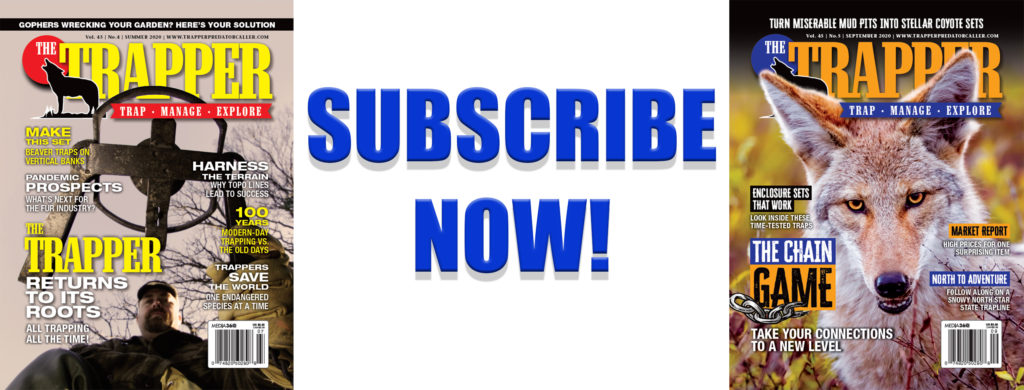By Serge Lariviére
Beavers remain the safest bet for respectable prices — and this is good news for a lot of people! Trappers from almost all areas of North America have access to beavers, so having a good market for that species is great news. Secondly, many trappers gain access to trapping land because of problem beavers, so if we have to trap them anyway, it is pleasant to know that we can make a buck doing the job that opened access to our trapping grounds! Thirdly, municipalities, county offices and railroad companies all appreciate having fewer beaver complaints to deal with, and when fur trappers can make a profit, even a small one, everyone else gets the beaver removal service for free.
In my neck of the woods here in eastern Canada, beaver complaints soared when prices plummeted, and beaver lodges started showing up where none had ever existed before. I suspect during this upcoming season that trappers will help restore the natural order of things and relieve beaver-induced flooding in both farmed and forested lands.
As you plan your beaver harvest, remember that the high prices are paid for the felt industry — the main uses being for hats — hence the trade name “hatter market.” The main thing to remember about beaver felt is that the underfur is what is really wanted, and beaver underfur grows heavier as fur primes. So, in other words, to take full advantages of this market this fall, make sure to not start too early and catch beavers before they fully prime up. But once they are prime, all beavers, large and small, perfect or damaged, will sell.
There are very few instances in the fur trade when damages to the hide itself has no impact, and the felt market is one of them. The main reason is, the leather from the beaver is NOT used, only the fur, which is removed from the leather through various ways (one of them being shaving). For this reason, if a pelt is fully prime, the impact of a few holes in it — even in critical places such as the middle of the back — has little or no impact on the price. And this allows for beaver prices to rise, because manufacturers do not have to pay the tanning of the leather. Of course, the market still wants the beaver properly put up, free of flesh and grease, and properly dried, but imperfections of the leather like false knife cuts or bite marks matter little. If you have access to beaver, catch them when they are prime and the price should dance around the $30 USD mark on average, which is in line with the results of the last international auction at Fur Harvesters Auctions (www.furharvesters.com). Trappers should capitalize on beavers in 2023 — as this is likely our most profitable animal right now.
Castoreum will no longer bring $100 per pound, and although the best can still fetch close to $60-$75 per pound, poorly handled or shells will drop below $20 USD per pound. As beaver harvest increases because of the fur price, so does castoreum, and thus the price is expected to drop.
Incidental otters caught in beaver traps should also bring about the same $30, with top skins bringing maybe twice that ($60). Wild mink will remain extremely low at averages between $5-$10 USD, which is terrible for such a fun animal to trap. Muskrats also struggle as the world tries to get rid of the thousands of ranch mink that were put on the market by farmers going out of business. Both muskrats and wild mink will likely remain low for several more years, until the excess fur that has flooded the markets gets taken out of storage and used up.
Raccoons need Russia to rise in price, and Russian buyers are still absent or unable to buy because of the political conflict and war. I do not believe that I have ever seen more roadkilled racccons, and I just think that there are very few longliners willing to target ‘coons when prices struggle to exceed $5 or even $10. If you must catch raccoons, catch them late when they are fully prime, and don’t expect anything more than $20 even for the largest and the best. Once the war is over between Russia and Ukraine, this item will likely return to normal. But we are still a few years away as there are also countless raccoon pelts still in storage awaiting an upswing in the market.
Fishers and martens have moved up and averages of $40 for both should be a good starting point, with larger and darker martens from northern areas bringing closer to $50-$55 averages. Canada lynx also should remain around $120 average, with top skins closer to $150. Western bobcats no longer bring a thousand dollars, but $300 should be a reachable average, with select skins approaching, but not exceeding, $900. Lesser quality bobcats will sell readily at $100-$150, as the industry produces cheaper “bobcat” jackets.
Coyotes have fallen back to low prices and no change is expected. If you have Western coyotes, catch them when they are prime. Unprime, pelted and Eastern coyote skins receive little interest at this time. If you sell coyotes round, many buyers now cannot pay more than $5-$8 because they also must pay $5-$10 for the skinning, fleshing and drying. No changes are expected in the red or gray fox market, and the only decent prices are those paid for cross and silver foxes.
Taxidermy goods such as wolves, wolverines and even black bears sell easily, and this is expected to last. If you catch anything unusual (totally white, totally black, unusual markings, etc.) or of exceptional size or quality, contact a few taxidermists — chances are, you will receive more than you would selling that skin on the regular fur market. And if you do, freeze the animal whole until you ask around — many taxidermist have customers waiting for odd and unusual animals — so call before you start skinning!





